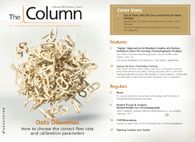Prehistoric cheese
Love it or hate it, cheese is everywhere in western diets, but have you ever wondered when cheese production began?
Love it or hate it, cheese is everywhere in western diets, but have you ever wondered when cheese production began?
The earliest evidence of prehistoric cheesemaking in Northern Europe has been published by an international team of researchers, headed by scientists at the University of Bristol (Bristol, UK). Published in Nature,1 the study puts forward a convincing case placing the origins of cheese production in the 6th millennium BC. The study could be key to unlocking the mystery of when humans began to develop dairy tolerance.
Milk products are a relatively new addition to the human diet, as genetic evidence suggests that prehistoric man lacked the capability to digest lactose. Over the last 10,000 years the human digestive system has developed and with it our ability to digest milk without becoming extremely ill. It is thought that this occurred gradually with the increased domestication of plants and cattle.2
In times of food shortages and harsh winters, milk would have been readily available from dairy cattle. The discovery of sieve-like artifacts from Neolithic archeological sites throughout northern Europe have supported a hypothesis formulated decades ago that cheese was produced by prehistoric man.
Peter Bogucki, co-author and supporter of the cheese production hypothesis, states that in his opinion cheese production would have allowed a reduction in the lactose content of milk, thereby enabling consumption of the dairy product without becoming ill.
Archeological theory suggests that Neolithic communities were the first farming settlements. Throughout the years, sieve-like artifacts have been collected from Neolithic archeological sites throughout northern Europe with suggested uses ranging from straining honey from honeycomb to covering fires.
This team chose to chemically analyse sieves excavated from Neolithic Linear Pottery settlements in the Kuyavia region of Poland. Using chromatographic [gas chromatography (GC)], spectrometric [gas chromatography–mass spectrometry (GC–MS)] and isotopic [GC–combustion–isotope ratio MS (GC–C–IRMS)] techniques, they found evidence for the use of sieves in cheese production.
High levels of lipids associated with dairy fats (and bacteria found in the stomachs of ruminants) were found trapped within the fabric of the 50 ceramic fragments predicted to have originated from 34 sieves — good evidence that the sieves were used to strain dairy products. In addition, chemical analysis of other non‑pierced vessels at the site indicated the presence of beeswax; a potential method of waterproofing pottery for milk storage.
Mélanie Salque, PhD student and co‑author of the study, said: “The presence of milk residues in sieves (which look like modern cheese‑strainers) constitutes the earliest direct evidence for cheesemaking. So far, early evidence for cheesemaking were mostly iconographic, that is to say murals showing milk processing, which dates to several millennia later than the cheese strainers.”
References
M. Salque, P. Bogucki, P. Pyzel, I. Sobkowiak‑Tabaka, R. Grygiel, M. Szmyt and R. Evershed, Nature, DOI: 10.1038/nature11698 (2012).
S. Schaffner & P. Sabeti, Nature Education 1(1) (www.nature.com/scitable/topicpage/evolutionary-adaption-in-the-human-lineage-12397) (2008).
Removing Double-Stranded RNA Impurities Using Chromatography
April 8th 2025Researchers from Agency for Science, Technology and Research in Singapore recently published a review article exploring how chromatography can be used to remove double-stranded RNA impurities during mRNA therapeutics production.
The Effect of Time and Tide On PFAS Concentrations in Estuaries
April 8th 2025Oliver Jones and Navneet Singh from RMIT University, Melbourne, Australia discuss a recent study they conducted to investigate the relationship between tidal cycles and PFAS concentrations in estuarine systems, and offer practical advice on the sample preparation and LC–MS/MS techniques they used to achieve the best results.










